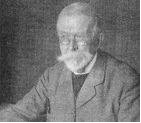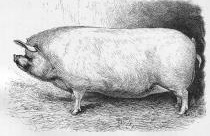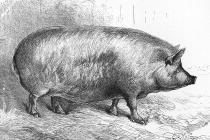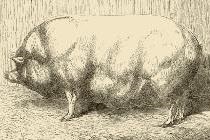Sanders Spencer
(ca 1841 – 5 Feb 1931)
The Large White, also known as the English Large White, is a breed of domestic pig originating in Yorkshire, hence also known as the Yorkshire pig.
First recognized in 1868, the breed is the progenitor of the American Yorkshire (or simply Yorkshire) in North America. The Large White is one of the most numerous of all pig breeds, widely used in crossbreeding for intensive pig farming around the world.
True to its name the breed is a big white-skinned pig, with erect ears and a dished face. It was originally developed as an outdoor breed, but today it is one of those favoured by commercial pig breeders, lending uniformity to pigs produced for meat on a large scale.
......
First recognised in 1868, the Large White was one of the original founder breeds of the National Pig Breeders' Association (now known as the British Pig Association) and the first herdbook was published in 1884
......
Before the end of the 19th Century, British Large Whites were already establishing themselves all over the world. Innovative pedigree breeders, such as Sanders Spencer of the Holywell herd near Huntingdon, were exporting breeding stock as far afield as Australia, Argentina, Canada and Russia as well as most countries in Europe.
Even if you happen to be porcivorous, the wonderful ongoing Youtube story of Esther the Wonder Pig is just about the nicest happiest most captivating thing on the internet – not since the movie Babe has a porker stolen the hearts of so many people worldwide. Just google "Esther the Wonder Pig" ...
And Esther is quite clearly of the American Yorkshire (aka English Large White) persuasion, owing her aristocratic pedigree in large part to Sanders Spencer back in late nineteenth century Huntingdonshire.
The History of the BPA:
The Foundation of Pedigree Pig Breeding

The National Pig Breeders Association was founded in 1884 at the instigation of Mr Sanders Spencer. In the early 1880's he saw the need for effective organisation amongst pig breeders. In collaboration with many eminent exhibitors and breeders of the time he laid the foundations of the NPBA and was appointed Honorary Secretary and Editor at the inaugural meeting. Those breeders who launched the NPBA in 1884 adopted a basic principle: they dedicated the association to the improvement of the breed of swine in the UK.
This mood is reflected in the introduction to the association's first herd book published on May 1, 1885. "I do not consider it advisable to introduce any controversial matter as to the superiority or antiquity of the Berkshire, Black, Tamworth or Yorkshire breeds," wrote the association's hon. secretary. "Neither will I attempt to prove that benefits are to be derived from a careful record of the pedigrees of the animals in which we may be particularly interested . . . the great success which has attended the various herd and stud books has completely settled that question." However, there could be doubts among some breeders, he suggested, that no standard of points existed to give a correct description of the variety of pig of which they were "especial admirers".



TOP: A Sanders Spencer Large White boar, 'Holywell Jimmy' MIDDLE: A Tamworth pig from Mr G Allender BOTTOM: The famous Middle White sow 'Miss Emily', the first 'Pig of the Year'
There followed a scale of points covering the main characteristics of the pig from head to hams to hair. Various additional references were also made relating to the individual breeds allowing "the reader to add as many of these as he pleases to the general standard of points."
Interestingly, although the association was formed with three breeds, the herd book published just a year after the formation included Berkshires, Blacks and Small Whites in addition to the three founder breeds. It is also worth noting that all could not have been easy for that first editing committee which laboured to produce the 106-page volume The preface says it all: "It is well-known that great difficulties are generally encountered in the compilation of the First Volume of any Stud or Herd Book. From various causes, greater difficulties than usual have been met with in bringing out this small volume, for which a favourable reception is asked."
The honorary secretary who drew up the list of standard points was one of the pioneers of modern pig breeding, Sanders Spencer of Holywell near Huntingdon. He founded the Holywell Herd of Large Whites in 1863 with the pigs being subsequently run in conjunction with a herd of animals from the same bloodline only with distinctive snouts and smaller dimensions – the Middle White. This Middle White line was founded on a sow called Busy Bee, a direct descendant of original Yorkshire stock.

But it was the Large White that began to make the biggest strides in popularity – with Holywell stock playing a significant part in the improvement of Danish pigs towards the end of the last century. It was, according to reports of the time, not uncommon for shipments of 20 pigs or more to be sent from Holywell to Denmark
And it was this surge of interest in upgrading the standards of pigs generally that led Alee Hobson, who was secretary of the association for 25 years, to write in the jubilee year (1934) issue of the NPBA Pig Breeders' Annual: "Improvement is a term which needs to be used relatively; but when change in conformation has been carried out concurrently with the improvement in growth and the proportion of higher-priced cuts, there can be no question of the wisdom which prompted Sanders Spencer and other pioneers to establish the NPBA."
In those later years of the 19th century, pedigree pig breeding reflected a strong interest among the aristocracy. The first president of the association was the Earl of Ellesmere, who was followed by Lord Moreton MP, of Tortworth Court, Falfield. The vice-presidents in 1885 were James Howard MP of Clapham Park, Bedford and Sir W. Throckmorton, Buckland, Faringdon. Breeders, however, were scattered throughout the country with the first Herd Book showing addresses from Suffolk to Somerset, Lincolnshire to Cheshire, and London to Leeds. As for the actual number of members, by January 1885 the association list showed a total of 109 pedigree breeders forming the nucleus of an organisation that was to grow in strength and achievements as the years progressed.
(continued)
Clarence [Threepwood], Earl of Emsworth (and perhaps even George Cyril Wellbeloved, his frequently drunken pig-man) would have venerated the name of Sanders Spencer, would in fact have held him in awe, second only to Augustus Whiffle, whose volume The Care of The Pig, (Popgood and Grooly, thirty-five shillings), was Clarence's Bible, in fact his bedtime reading, consulted at every juncture or crisis in the career of The Empress of Blandings, oft-time winner of the Fat Pig category at the annual Shropshire Agricultural Show.
Fortunately for posterity, the author James Hogg happened upon Lord Emsworth's annotated personal copy of Whiffle's magisterial tome, and edited it down to a more manageable size for republication by Michael Joseph in 1991 – I recently acquired an excellent second-hand copy for a mere £0.01 from the internet.
But towards the end of his professional career, Sanders Spencer too had distilled many decades of experience in the breeding and rearing of pigs into a volume entitled Pigs: Breeds and Management. However it is uncertain as to whether the contents of this authoritative treatise ever came to the attention of the notoriously feather-brained ninth Earl.

(Click here for facsimile page-turning version)
As always with such online facsimile versions, the maximal screen display can be achieved by using a judicious combination of the options Fullscreen / F11 / Hide Nav Bar / Zoom custom
There was a remarkable coincidence in date of publication of these two entirely independent works – both first appeared in 1898, although Whiffle brought out a second edition in 1915. In both volumes, he disparaged the contributions of Youatt et al to the subject, going so far as to accuse them of plagiarism even though Youatt himself had posthumously brought out a highly-regarded volume, The Pig: a Treatise on the Breeds, Management, Feeding, and Medical Treatment of Swine; with Directions for salting Pork and curing Bacon and Hams, as far back as 1847.

(Click here for facsimile page-turning version)
As always with such online facsimile versions, the maximal screen display can be achieved by using a judicious combination of the options Fullscreen / F11 / Hide Nav Bar / Zoom custom
As the world continues to go to hell in a handcart, it's comforting to take refuge in civilised and well-told narratives of earlier eras that relate to time-honoured traditions reflecting the essential peaceful character of British life, like leaning on the side of a sty and absent-mindedly scratching the back of a pig as it awaits its daily ration of 57,800 calories, comprising barley meal, maize meal, linseed meal, potatoes and separated buttermilk, as per Whiffle ...
So what's not to like about the themes of the following recently-published volumes for the general reader, about the historical, cultural and practical aspects of the pig's relationship with us humans in the British Isles.
- The English Pig: A History
By Robert Malcolmson and Stephanos Mastoris
Published by The Hambledon Press, London 2003

The English Pig is an account of pigs and pig-keeping from the sixteenth century to modern times, concentrating on the domestic, cottage pig, rather than commercial farming. In Victorian England the pig was an integral part of village life: both visible and essential. Living in close proximity to its owners, fed on scraps and the subject of perennial interest, the pig when dead provided the means to repay social and monetary debts as well as excellent meat.
While the words associated with the pig, such as 'hoggish', 'swine' and 'pigsty', and phrases like 'greedy as a pig', associate the pig with greed and dirt, this book shows the pig's virtues, intelligence and distinctive character. It is a portrait of one of the most recognisable but least known of farm animals, seen here also in many photographs and other representations. The pig has a modest place in literature from Fielding's pig-keeping Parson Trulliber to Hardy's Jude the Obscure and to Flora Thompson's Lark Rise to Candleford. In modern times, while vanishing from the sight of most people, it has been sentimentalised in children's stories and commercialised in advertisements.
- The Pig: A British History
By Julian Wiseman
Published by Gerald Duckworth & Co, London 2000

This fascinating history of one of our best-loved animals, first published in 1986 to much critical acclaim, traces the development of the pig as an integral part of agriculture and describes the remarkable changes that have taken place both in its breeding and in its husbandry. This new edition, richly illustrated with paintings, photographs and line drawings, includes the famous "Dissertation upon Roast Pig" by Charles Lamb, along with a new introduction and updated final chapter taking account of the most recent agricultural developments regarding the powerful pig in our society.
- The Whole Hog: Exploring the Extraordinary Potential of Pigs
By Lyall Watson
Published by Profile Books Ltd, London EC1 2LX, 2004

The Whole Hog is just that, an attempt to encompass everything that is known about all the pigs of the world.
In recounting his close encounters with wild pigs on three continents, Lyall Watson explores how profoundly pigs have succeeded, from the Gadarene Swine to Miss Piggy, in capturing our imagination.
He also makes some surprising revelations. Pigs may lack big brains and grasping hands but they nevertheless manipulate their environment in ways that demonstrate learning, memory, abstract thought, a capacity for pleasure and a real aptitude for reason.
Pigs have been seriously neglected and consequently suffer from an unjustified bad press, but in truth pigs and people have a lot in common. We are both the recently domesticated result of a long tradition of gregarious, playful, tuneful, caring and highly resourceful beings. And all that prevents us from admitting pigs to the society of creatures who understand each other, comprehend complex relationships, distinguish between self and non-self, and regularly respond to situations in a conceptual way, is that those we most often see are confined to tiny sties.
The Whole Hog is an eye-opening new look at pigs as they really are, and an antidote to centuries of superstition and taboo. In fact it is nothing less than a clarion call for an honest reassessment of hoggish behaviour, and a celebration of the fascinating, true nature of pigs.
When it comes to real intelligence, Lyall Watson suggests that pigs deserve to be considered up there with elephants, dolphins and the great apes.
I find it interesting that while the earlier and later Abrahamic religions despise and abhor the pig, Christianity has no issues whatsoever (as far as I know) with this animal – perhaps because the synthesis of Christian dogma owed so much to the Hellenic and Egyptian traditions, which seem to have had no such problems with porcine character or lifestyle.
Pigs are undeniably highly intelligent beings – as witness Orwell's shrewd choice of pigs as leaders of the rebellion against Farmer Jones in the iconic satire Animal Farm – but also as co-conspirators in the eventual betrayal of the other animals' simple trust in them.
The pithy folksy aphorism that "Dogs looks up to us, cats looks down on us, but pigs is equals", seems pure Josh Billings to me, but is generally attributed to Winston Churchill in the slightly less snappy version "Dogs look up to us, cats look down on us, but pigs treat us as equals".
And as we humans too like to regard ourselves as intelligent creatures, perhaps there should be a pact that we don't eat another such creature. But the serpentine hiss of Satan says (just like the Reluctant Cannibal's father in the eponymous Flanders & Swann song), "If God hadn't intended us to eat pigs / people, why did he make he make them / us of meat?" (Though pigs may well be induced to eat humans, as per the life-sentences handed down to the Arthur & Nizamodeen Hosein brothers in 1970, who were suspected of having fed their murder victim to their pigs.)
I'm deeply sympathetic to vegetarianism, and in fact am a de facto adherent as my wife Sonia prepares and cooks all our wonderful meals (after which I generally deal with the washing up of the innumerable plates, pans and utensils involved, in case you wondered) – but there would also be something irresistible about the aroma and taste of (say) a bacon sandwich if such were to materialise. And indeed she readily admits that bacon (in particular) was the hardest thing to forswear when she defected to vegetarianism in her idealistic teenage years.
The Scots and the Jews
I've often reflected over the years on the striking similarities between the Scots and the Jews, two peoples who together with the ancient Greeks have made a greater cultural and scientific contribution per capita to the world than any other.
Some specific points of similarity are of course reverence for scholarship, renown for financial acumen, emphasis on family loyalty, and observance of the Sabbath.
But I'd never before been aware of a commonality between them of aversion to pork, or to pigs generally, until coming across the following effort in the Stairs family history referenced in The Townend Family Residences.
Item the Eleventh was puzzling, until just two days later I came across an explanation, or amplification, of it on p 215 of The Whole Hog featured above –
Please click below for a very thorough and level-headed account of the uneasy Scottish attitude to pigs.






